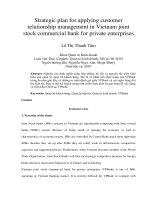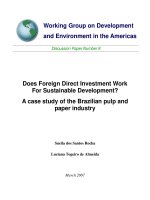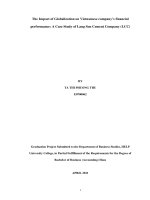capital management in vietnam’s shipbuilding industry, applying accounting policy, supplying relevant information for financial managers a case study on vinashin (vietnam shipbuilding industry group)
Bạn đang xem bản rút gọn của tài liệu. Xem và tải ngay bản đầy đủ của tài liệu tại đây (1.05 MB, 86 trang )
CAPITAL MANAGEMENT IN VIETNAM’S SHIPBUILDING
INDUSTRY, APPLYING ACCOUNTING POLICY, SUPPLYING
RELEVANT INFORMATION FOR FINANCIAL MANAGERS: A CASE
STUDY ON VINASHIN (VIETNAM SHIPBUILDING INDUSTRY
GROUP)
BY
NGO VIET ANH
E0700271
Graduation Project Submitted to the Department of Business Studies,
HELP University College, in Partial Fulfillment of the Requirements for
the Degree of Bachelor of Business (Accounting) Hons
OCTOBER 2011
ii
DECLARATION OF ORGINALITY AND
WORD COUNT
I hereby declare that the graduation project is based on my original work except
quotations and citations, which has been duly acknowledged. I also declare that it has
not been previously or concurrently submitted for any other course/degree at Help
University or other institutions. The word count is 13,564 words.
NGO VIET ANH
17 October 2011
iii
ACKNOWLEDGEMENT
First of all, I would like to express my sincere appreciation to my supervisor, Dr. Le
Van Lien who has guided me throughout this thesis. His constant guidance,
insightful suggestions, and constructive ideas are the essential inputs and
encouragement for me in order to complete this thesis.
Next, In addition, I would like to send my gratitude to the International School and
HELP University College for giving me an opportunity to conduct my study in my
favorite area.
Furthermore, I also address my appreciation to Mr. Chu Van Hung (Financial
Professor) who supported my thesis with information related to my thesis. My
thankfulness is also addressed to others who have helped me since the beginning of
my study until I can finish my thesis.
Lastly, I would also like to extend my heartfelt gratitude to my family and my friends
for their continuous support, encouragement and contribution, which have been
crucial during the presentation of this report.
My thesis cannot be finished without your supports.
iv
CAPITAL MANAGEMENT IN VIETNAM’S SHIPBUILDING INDUSTRY,
APPLYING ACCOUNTING POLICY, SUPPLYING RELEVANT
INFORMATION FOR FINANCIAL MANAGERS: A CASE STUDY ON
VINASHIN (VIETNAM SHIPBUILDING INDUSTRY GROUP)
BY
NGO VIET ANH
OCTOBER 2010
Supervisor: Dr. LE VAN LIEN
ABSTRACT
The purpose of this paper is to analysis the capital management, especially
management of efficiency use of capital of which concept of capital, efficiency use
of capital, roles of capital, and making decision on capital management are mainly
concentration. If a company has a well managed capital, the company will run
effectively and create profits. Nevertheless, when there is failure in managing capital
effectively, it can cause losses for the business and lead them to dissolution or
bankruptcy. It is mostly occurred in SOEs because of their management tend to have
weaknesses, shortcomings and wrongdoings. VINASHIN is specific case of failure
in managing capital effectively. In this thesis, I would like to discuss the failure in
capital management of VINASHIN, and then suggest some solutions and
recommendations for the organization.
v
TABLE OF CONTENT
Page
Declaration of Originality and Word Count
ii
Acknowledgment
iii
Abstract
iv
Table of content
v
List of figure
ix
List of tables
x
List of Abbreviations
xi
CHAPTER 1
INTRODUCTION
1.1 Background of the thesis
1
1.2 Aims of the project
3
1.3 Problem statement
4
1.4 Structure of the thesis
5
1.4 Limitation
6
CHAPTER 2
LITERATURE REVIEW
2.1 Background of capital and the necessary to manage capital efficiency
7
vi
2.1.1 Capital and important of capital in SOEs
7
2.1.1.1 Definition of capital
7
2.1.1.2 Definition of efficiency of capital
8
2.1.2 Classification of capital and sources of capital
10
2.1.2.1 Capital classification method based on rotation
10
2.1.2.2 Classification by source of capital formation
13
2.1.2.3 Classification by time to acquisition
15
2.1.3 Roles of capital
15
2.1.4 Factors affected the efficiency of capital
17
2.1.4.1 Objective factors
17
2.1.4.2 Subjective factors
19
2.2 Capital management decision making in Vietnam’s SOEs
21
2.2.1 Factors affected financial decision
21
2.2.2 Roles of Vietnam’s SOEs in market economy
23
2.2.3 The decision making in Vietnam’s SOEs
26
2.3 Measurement of efficiency use of capital
28
2.3.1 The need to improve the efficiency use of capital
28
2.3.2 Criteria to evaluate effectiveness of capital
29
2.3.2.1 Based on efficiency ratios
29
2.3.2.2 Criteria to evaluate firm’s ability to pay short-term debts
31
2.3.2.3 Criteria to evaluate firm’s ability to pay long-term debts
32
2.3.2.4 Criteria to evaluate effectiveness of management
33
vii
CHAPTER 3
RESEARCH METHODOLOGY
3.1 Research objectives
35
3.2 Data sources
36
3.3 Research methodology
37
3.3.1 Primary data
37
3.3.2 Secondary data
37
3.4 Data Collection
38
3.5 Research tool
39
3.5 Limitation of Research
39
CHAPTER 4 CASE STUDY ANALYSIS
4.1 Background of VINASHIN
41
4.1.1 Short history
42
4.1.2 Group’s businesses
43
4.1.3 Business strategy and function
43
4.1.4 Development
44
4.1.5 Organizational structure
46
4.1.6 Accounting policy adopted
48
4.2 Assessment of capital management in VINASHIN
48
4.2.1 Overview of funding situation
48
viii
4.2.2 From of funding in VINASHIN
51
4.2.3 Analysis of efficiency of capital
53
4.3 The failure of VINASHIN in capital management
55
4.3.1 The downfall of VINASHIN
55
4.3.2 Causes of the downfall
56
4.3.2.1 Subjective causes
57
4.3.2.2 Objective causes
62
4.4 Solutions to VINASHIN
63
CHAPTER 5 CONCLUSION
5.1 Conclusion
66
5.2 Recommendation
67
BIBILIOGRAPHY
69
APPENDICES
72
ix
LIST OF FIGURES
Figure 1: VINASHIN’s organizational structure
Figure 2: Broad of management
x
LIST OF TABLES
Table 1: Balance sheet of VINASHIN from 2008 – 2009
Table 2: Asset volatility
Table 3: Capital volatility
Table 4: Ratio analysis for efficiency of capital
xi
LIST OF ABBREVIATIONS
SOEs: State-Owned Enterprises
VINASHIN: Vietnam Shipbuilding Industry Group
VND: Viet Nam Dong
DWT: Dead Weight Tonnage
DVN: Det Norske Veritas
ROTC: Return on total capital
ROA: Return on assets
ROE: Return on equity
CR: Current ratio
WTO: World Trade Organization
CHAPTER 1: INTRODUCTION
In this chapter, we will lay a foundation for the entire thesis. The chapter introduces
background of the thesis. Then, we will describe the objectives, problem statement,
and limitation of the thesis. Finally, the chapter will cover the structure of the thesis.
1.1. BACKGROUND OF THE THESIS
To conduct business production activities, any business enterprises need to have
a certain amount of capital and financing. Capital is the premise of production and
business. But how to use capital effectively is the key for determining factor for the
growth of every business. Therefore, in order to make a well ongoing enterprise, any
enterprises should put capital management in the first priority then makes sure their
management of capital effectively because the effective use of capital directly
affected to the existence and development of the company.
Capital is the backbone for success in any business because capital is first priority
to determine businesses’ existence and development. Tasks of capital consist of
establishing, operating, and developing the enterprise. Moreover, capital is used not
only to pay ongoing expenses but also to purchase both current and non-current
assets such as inventories, equipment, buildings, and property. In addition, capital in
2
an organization is used for other purposes such as paying salaries, credit extension to
customers, advertising expenses, insurance expenses, and many other day-to-day
operations. Furthermore, profitability is determined in part by the way, in which a
business manages its capital. There will be a drop in profit if the businesses are
unable to manage the capital effectively. Therefore, how the business obtains and use
capital will determine its success
Vietnam is one of the fastest growing economies in the world. Vietnamese
market is committed to “market-oriented socialism”. Therefore, state-owned sectors
are backbone of our economy, especially State-Owned Enterprises (SOEs). By early
2006, there are 4,086 SOEs in Vietnam, accounting for only 3.6% of the total active
enterprises (www.vn.economy.com.vn). The changes in Vietnam’s economy and
market since the launch Doi Moi in the 1980s and the join in WTO in the twenty
century have made the Vietnam’s market rapidly growth and strong development. In
the market economy, the strong and developed organizations will dominate the
market. Therefore, the role of SOEs will be overshadowed and private enterprises
will alternative. Nevertheless, in Vietnam the SOEs play key role to decide the State
economy. Therefore, the success or failure of SOEs in Vietnam has great affects on
the growth of the market. Nowadays, the world economic downturn has great
affected to the operation of SOEs because of they are not successful when obtain and
use their capital. According to a report by the Ministry of Planning and Investment,
Vietnam had 36,607 projects which used capital from the state budget in 2010 of
which 296 projects have been close down because of squandering of investments.
SOEs is influenced from re-innovation when joining WTO as well as the trend of
economic down turn so it caused big losses in SOEs. According to Vietnam Business
News, the biggest losses of SOEs in Vietnam when inefficient use of capital consist
3
of Vietnam Cement Corporation, Coffee Corporation, Transport Work Construction
Companies 5 and 6, Thang Long Construction Corporation, Sericulture Corporation
with losses from VND220 to VND1,352 billion, 13 times more than the average
capital of SOEs (www.vn.economy.com.vn). The loss is caused from the
weaknesses of SOEs. The most major reasons for the weakness of SOEs come from
weaknesses in capital management include weaknesses and wrongdoings of leaders,
investment spread, poor use of capital investment, waste in preproduction process,
and higher payment their expenditure. The weak in capital management has corroded
their capital. Therefore, it is necessary to improve the capital management in SOEs,
especially in today’s difficult times of obtaining capital.
As results, it is necessary to have effective capital management, especially when
capital has been scared day-by-day in today’s world. In the thesis, we will have a
specific view at the capital management in Vietnam Shipbuilding Industry Group
(VINASHIN) as specific example of insufficient use of capital.
1.2. AIMS OF THE PROJECT
The project is developed to explore the important, impacts of management of capital
on Vietnam’s organizations, especially in SOEs. The thesis focuses on management
of capital within an organization by analyze the statistics, facts as well as underlying
market drivers to provide the readers with real insights into real case study of
VINASHIN.
When we have completed this thesis, we will:
4
Have background of capital, management of capital
Appreciate situations related to the management of capital in specific case of
VINASHIN
Give solutions and recommendations for VINASHIN
1.3. PROBLEM STATEMENT
Nowadays, funding is the most difficult thing. The best way to fund the business is
borrowing money from debts and liability. However, it is also double-edged sword.
If a company with well capital managed, their debts and liability will create profits
through profitability investment projects. On the other hand, if their debts and
liability is used ineffective it can cause a huge bad debt, which unable to pay. In
times of economic difficulty, the higher the proportion of long-term debt can create
the more exposed the enterprises are. Therefore, enterprises need to consideration
when investment. However, in the case of VINASHIN, the group continues to
borrow money with liabilities and debts although its operations and investment are
not effectively. It may cause from the shortcomings of VINASHIN’s management of
capital. Therefore, in chapter 4 of this thesis, a real case of VINASHIN will be use
for analysis as particular example of capital management under following questions:
What are problems of capital management of VINASHIN?
Why problems have occurred?
What are the best solutions and recommendations for VINASHIN’s
situations?
5
Following this thesis, the readers will have acknowledgement related to the topic,
which almost completed without its limitation.
1.4. STRUCTURE OF THE THESIS
The thesis will be presented in five chapters as following:
Chapter 1: Introduction
Chapter 2: Literature review
Chapter 3: Research and methodology
Chapter 4: Case study analysis
Chapter 5: Conclusion
The introduction of chapter 1 will present the general picture about the relating topic.
With Literature review of chapter 2, you will have general knowledge about capital,
efficiency of capital, classification of capital, roles of capital, factor affected
efficiency of capital, important of decision making in managing capital, and criteria
to evaluate the efficiency of capital.
In the chapter 3, it describes research methodology consist of research objective, data
sources of which primary data and secondary data, data collection and research tools.
6
Case study will be analyzed in chapter 4. Chapter 4 will analyze capital management
in specific case of VINASHIN, a SOE, to know general about how they obtain and
use capital. In addition, we will appreciate its issues from failure of management of
capital, and then provide the reasons as well as solutions for the issues.
The conclusion of chapter 5 will provide to you sum up of the analysis from above
chapter, and then give recommendation for the problem.
1.5. LIMITATION
The thesis is limited to further discussion of related topic because of time
constraining and scare of information.
Finance has limitations because market timing, value of money, and recession so this
thesis has similar limitations. As results, this thesis could not verify accuracy of
financial data provided by the company reports.
Because of limited time, in this thesis, I only concentrate on capital management
related to management of efficient use of capital in enterprises, especially SOEs in
the specific case of VINASHIN.
7
CHAPTER 2: LITERATURE VIEW
The purpose of this chapter is to introduce the general view about capital and capital
management. In addition, this chapter provides financial instruments related to
capital management. Furthermore, in this chapter, we will know how capital
management effected to decision-making in enterprises, especially in SOEs
2.1. BACGROUND OF CAPITAL AND THE NESSARY
TO MANAGE CAPITAL EFFICIENCY
2.1.1. Capital and Important of Capital in SOEs
2.1.1.1.Definition of Capital
Business activities require capital investment. We can say that capital is a
prerequisite for all activities of the business. As we known, before going into
operations business must register the legal capital.
Capital is expressed as the value of all assets managed by the enterprise and
used at a certain time. There are various meaning of capital. According to Jean
Murray, “Capital is accumulated assets or ownership”. Capital, in other word, is
described as the amount of cash and other assets owned by the business.
8
Money is a form of initial capital of enterprises, but not already surely there is
money be there is capital. Money is only as potential capital. To turn into capital,
money must put into business’s productions with the aim to making profits. In
addition, stock or ownership in an enterprise can be a form of company’s capital.
In short, the capital is advanced by the value of all assets controlled by the
enterprise to serve the business and production activities to obtain economic benefits
in the future.
2.1.1.2.Definition of Efficiency of Capital
In order to eliminate management of capital, we need to understand how the
business use their capital or in other word, efficiency of capital.
Efficiency is a concept that is always mentioned in the economic market.
Enterprises always toward economic efficiency while government efforts to achieve
economic and social efficiency.
Efficient use of capital is required to ensure that businesses gain the benefit of
investors, the employees, the State in terms of income and ensure the survival and
development of the enterprises themselves. Moreover, it is also the basis for business
can be easy to raise capital on financial markets to expand production and business
development.
Therefore, it is important to clarify the nature and standard of efficiency use
of capital for enterprises. Because the need to have broad consensus on awareness
and views of our businesses, especially SOEs in current conditions. At the same
9
time, it also helped solve the problem of appraising the quality of running business,
the valuation of corporate assets, corporate restructuring, renovate corporate
management structure and economic mechanism.
Efficient use of capital is often misunderstood business efficiency but in fact,
it is only one side of the business performance, which is the most important aspect.
General speaking, one of the elements of business performance can be ineffective.
On the other hand, speaking to efficient use of capital cannot be said that using
capital effective but the results is loss, i.e. the efficient use of funds is showed on two
sides, preserving capital is created forward to the target results of the business,
especially including the profitable of capital.
Beneficial results from the use of capital must satisfy two requirements: To
meet the interests of the business and interests of investors in the highest degree of
desired benefits while improving benefits of the economy society. In the modern
market economy, any business brings more profit for themselves, but they harm the
common interests of the social economy will not be allowed to operate. Conversely,
if the business activities were beneficial to the economy, but created losses to the
business, then it would make the business going to bankruptcy. Thus, the results
generated by the use of capital are consistent with the results of the business interests
and the interests of socio-economic background.
So efficient use of capital is typically only one side of the business
performance, as a category reflects the degree of economic, energy exploitation and
utilization of capital and assets in production and business activities to goals to
maximize benefits and minimize costs.
10
Analyze the effective use of capital and business can be conducted in three
content: analysis of efficiency of working capital, fixed capital and capital efficient
business use in general.
2.1.2. Classifications of Capital and Sources of Capital
During production, business enterprises consume expenditures such as supplies,
materials, equipment depreciation, and salaries. That is the cost of the corporation
spends to achieve business goals. The problem is this cost arises frequently,
continuous associated with production processes of the enterprises. Therefore,
enterprises must improve the efficiency of capital as much as possible to achieve the
highest business objectives. In order to manage and closely supervise the
implementation of the cost, capital efficiency, cost savings at each stage of
production and the entire company, it is needed to classify capital. The effects of
capital classification include inspect, analyze the process of the incurred costs, which
the enterprise had to spend on business production. There are many classifications of
capital. Depending on different point of view, we have different classifications of
capital.
2.1.2.1.Capital classification method based on rotation
a. Fixed Capital
In business market, money is needed for payments of expenditures of a
company related to fixed assets. Under Vietnam’s government regulation, fixed
11
assets must have two characteristics: (1) have great value (over 5 million VND), and
(2) worth used over one year. The advance investment capital to buy, sell, construct,
and transfer intangible and tangible fixed assets is called fixed capital. According to
David Ricardo, fixed capital is described as any kind of real or physical capital (fixed
asset) that is not used up in the production of a product and is contrasted with
circulating capital such as raw materials, operating expenses and the like
(en.wikipedia.org). Fixed capital is essential because if we use it effectively,
company will create large proportion of profits.
In business enterprises, fixed capital plays a vital role in the production of
product. It determines innovation of technology, equipment of technical facilities,
and primary factor to secured enlarging re-production as well as improving
employees’ living standard. Therefore, it is essential to manage capital effectively.
The size of fixed capital will determine the size of fixed assets that has huge effects
on business’s operations. On the other hand, economic characteristics of fixed assets
in application process have a decisive influence in transferred cycle of fixed capital.
Fixed capital expressed into two forms:
(i) In physical form: It is all fixed assets used in business enterprises. It
includes land, buildings, property, office equipment and furniture,
vehicles, etc.
(ii) In monetary form: It is all fixed assets, which are not depreciation and
amortization of capital when not being used for the production of fixed
assets. It is part of fixed capital that finished the completely rotate and
return to the original form of currency.
12
b. Working Capital
Working capital is managed to determine profitability of the firm. It is defined as
a firm’s investment in capital (J.William Petty, A.J., J.D., Martin, et al). Working is
described as the dollar amount or the total of a firm’s current assets by Josephe.
Finnerty. Cash, accounts receivable, and inventories are the main form of current
assets.
Working capital can initially be broken into two types: permanent and temporary.
Permanent working capital is tied up in keeping the business flowing throughout the
year. Temporary working capital is needed from time to time to take account of
seasonal, cyclical or unexpected fluctuation in the business. In addition, it is usually
serviced from an overdraft facility.
There are three basic applications of working capital consist of inventories,
debtors, and cash.
Firstly, inventories comprise primary stocks of goods that are held for resale, a
prominent asset for retailers, wholesalers and manufacturers. Inventories can be
further split into inventories of raw materials, work in progress and finished goods. If
inventories do not well managed, they can soak up an enormous amount of excess
working capital. It is the job of the financial manager to minimize the stocks of raw
materials, the level of the work in progress, and the quantity of finished goods.
Secondly, on the debtor side, working capital is required to finance the gap
between payment due to suppliers and payment owned by customers. Main types of
working capital on the debtor side are account payables and notes payable. Accounts
payable are the converse of account receivable, comprising mainly the firm’s debts
13
that arise from trade credit that creditors have advanced to the firm while Notes
payable are shorter sources of finance that are payable on maturity date. The primary
task of financial manager on the debtor side is examining whether generous credit
term are negotiated with suppliers but minimal credit is offered to customers.
Finally, cash is needed to management of working capital. Cash consists of cash
in hand (money) and bank accounts and credits. Financial managers manage cash to
ensure that it is always available for meeting the company’s day-to-day transactions
and debts.
2.1.2.2.Classification by source of capital formation
According to this classification, the capital of the enterprise includes Liabilities and
Owners’ Equity. In the process of production of business, outside of its own capital,
the businesses themselves have also to use a large borrowing capital through banks,
customers and partners. All these elements are formed the liabilities of the business.
a. Liabilities
According to The IASB Framework, paragraph 49b, liability is described as a
present obligation of the entity arising from past events, the settlement of which is
expected to result in an outflow from the entity of resources embodying economic
benefits (ww.iasb.org).
14
Definition of liability has two main elements relating to the existence of a
present obligation and a past transaction. Obligation can come from numerous ways
such as cash payment, provision of services, transfer of assets, and a credit. One
example of obligation is accounts payable.
In SOEs, sources of liability come from banks, intermediary financial
instruments such as pension funds and lease financing, issued bonds, and borrowed
from members of the entity.
b. Owners’ Equity
Owner’s Equity is capital belong to the owner of the business who have
ownership, management, and making decisions on the assets of the business. There
are three primary sources to create owners’ equity of the business as following:
(i) Venture capital includes capital contributions (The State, venture
firms, shareholders, and owners of the business) and the undistributed
profits of results of business production.
(ii) Differences on revaluation of assets (mainly fixed assets): When the
State allowed or members of company decided.
(iii) The funds of the enterprise: forms of the business production such as
development funds, reserve funds, pension funds.
In addition, the owners’ equity of the business also including capital
investment in infrastructure and business funds (funds granted by the State budget,









